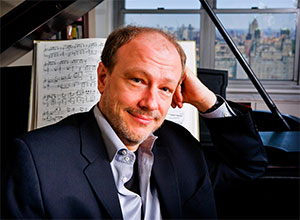by Mike Telin

All three programs also include Haydn’s Piano Concerto No. 11 in D major featuring Marc-André Hamelin as soloist. “I’m looking forward to the concerts very much because this is my debut with The Cleveland Orchestra,” the friendly Hamelin said during a telephone conversation from his home in Boston. “I know they have tried to engage me at least once before. It’s always a problem with dates. Sometimes it just takes time for schedules to work out, but I’m happy that it did.” The concerts will also mark the first time that the Montreal-born pianist will collaborate with Matthew Halls. “I’ve never worked with him, but I am looking forward to it.”
Haydn’s 11th keyboard concerto, written between 1780 and 1783, was originally composed for harpsichord or fortepiano. “The concerto is not programmed very often and it’s a shame, because I think Haydn’s concertos have their place just as much as the concertos of Brahms, Rachmaninoff or Beethoven. Haydn’s music has a lot to offer, and this concerto in particular is always a great favorite with audiences. It’s full of energy and little surprises. The slow movement is particularly beautiful.”
Hamelin pointed out that he will be playing cadenzas written by famous harpsichordist Wanda Landowska. “The second movement cadenza is especially wonderful. It’s not a show stopper but certainly a time stopper. Even though she uses material that is largely Haydn’s, she uses it in her own way. It just makes you want to close your eyes and drift in the best possible sense.”
Recently Hamelin has spent a lot of time with the concerto, having played it with the Canadian early music ensemble Les Violons du Roy on their recent American tour. And speaking of the cadenzas, one reviewer noted that the second movement cadenza seemed to channel the great jazz pianist Bill Evans. I mention this to Hamelin. “You will see,” he said laughing, “but if you can’t wait, the cadenza is on my recording as well. When I recorded the third and fourth concertos I had to write my own cadenzas because none of the ones that have come to us have been authenticated as being by Haydn, not even for this concerto.”
Last month Hamelin released two CDs on the Hyperion label, one with the Tákacs Quartet of Shostakovich’s Piano Quintet in G minor op. 57, the other of Mozart piano sonatas, his first Mozart recording. “It is my first Mozart recording, although I did record the G major concerto (No. 17) about 20 years ago. It’s largely forgotten and perhaps deservedly so. But yes, this is the first time I’ve recorded Mozart sonatas and it’s an absolutely fascinating world.”
Why did Hamelin wait so long to record the music of Mozart? “It’s been on my mind for some time, but it’s really that I can’t do everything at once of course. I wish I could do more, but as you get older things take more time. You can’t rush things.”
When not performing, Hamelin practices his other musical craft: composing. Does being a composer influence his approach to playing? “Very much. Being a composer brings you closer to whoever’s work you perform. You have much more of an insight into how the compositions were put together, and I think being a composer enables you to make better interpretive decisions.”
Published on ClevelandClassical.com April 28, 2015.
Click here for a printable copy of this article



